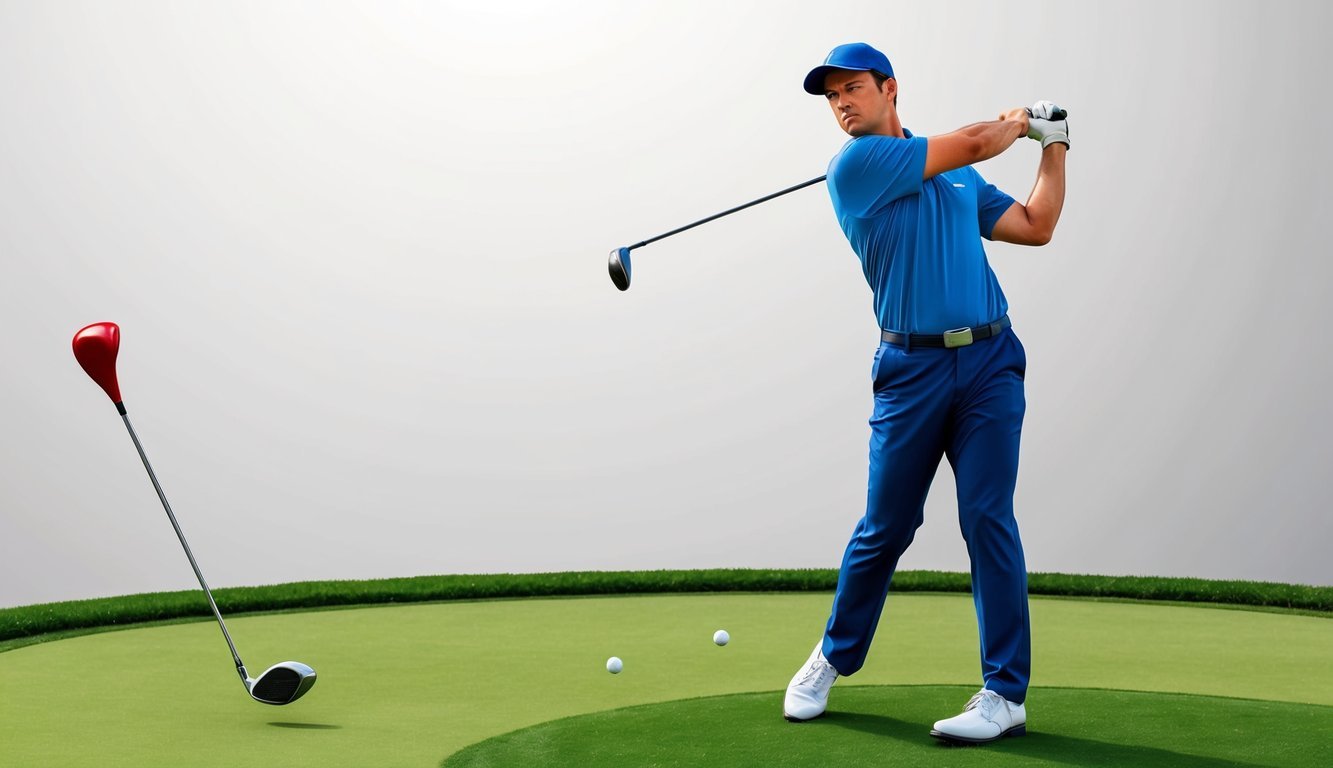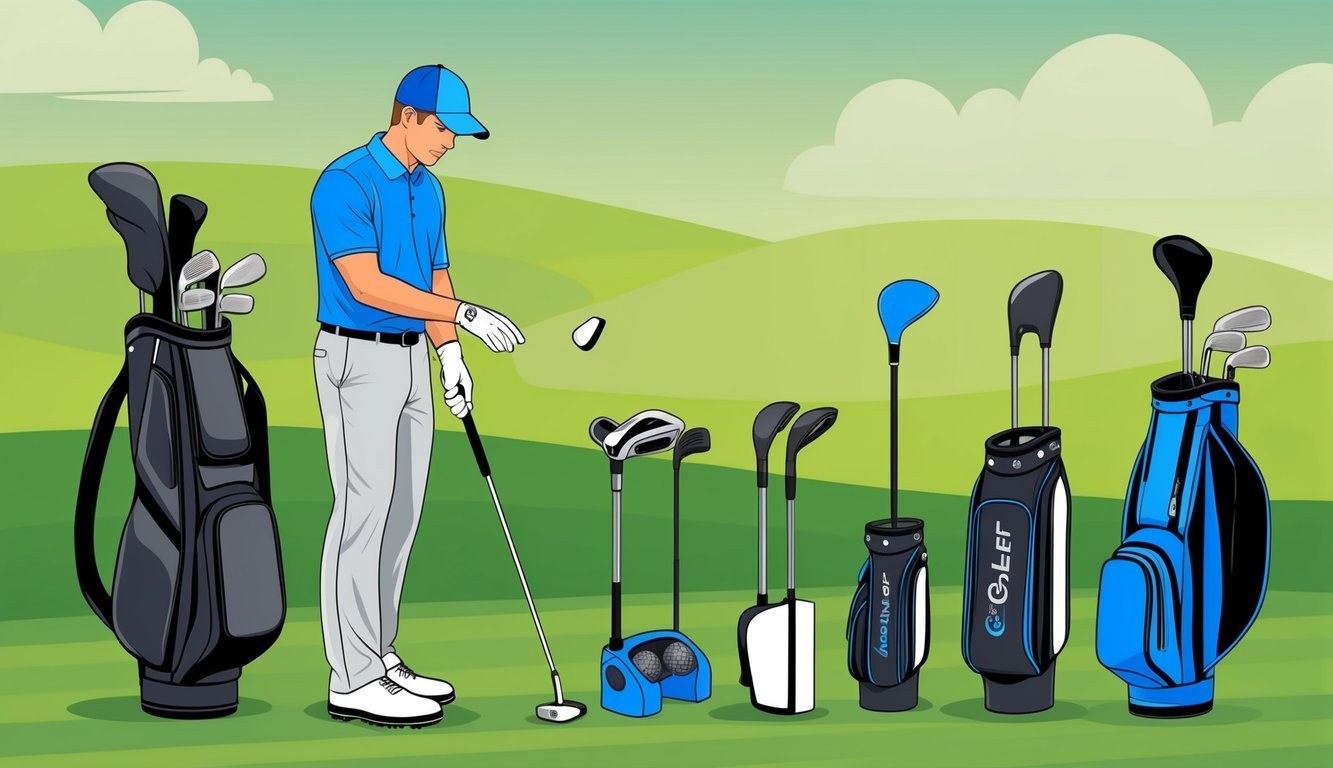Getting rid of a golf slice can feel like a daunting task, but understanding the core issues makes it manageable and even enjoyable.
A slice occurs when the ball curves dramatically from left to right for right-handed golfers.
Observing your swing, clubface, and stance are crucial in diagnosing this common problem.
You can significantly reduce or even eliminate your slice by focusing on proper wrist action.
Also, ensure your setup promotes a square clubface at impact.

It’s not just about knowing what a slice is, but also about the actions you can take to fix it.
Adjusting your grip, stance, and swing path can make a significant difference.
Whether it’s shifting your weight correctly or practicing club release, these technical aspects play a vital role.
Aligning these elements will help you maintain a straighter ball flight.
Using visual aids like placing a headcover outside your swing path is a practical step that helps improve accuracy.
Understanding your equipment can also be key.
Sometimes it’s as simple as reevaluating the clubs you’re using.
Clubs that offer more forgiveness can aid in correcting mishits that contribute to a slice.
Yet, the most effective change often lies in refining your technique and employing targeted practice strategies.
Key Takeaways
- Focus on proper wrist action for a square clubface.
- Adjust grip, stance, and swing path to improve accuracy.
- Reevaluate golf equipment for better performance.
Understanding the Basics of a Golf Slice
A golf slice is a common issue that affects many players and can significantly impact your game.
It occurs due to various factors like the position of your clubface or the path of your swing, causing the ball to veer off-course.
Defining a Slice in Golf
A slice in golf refers to a shot with a curving trajectory, typically moving from left to right for right-handed golfers.
This unintentional curve often results from an open clubface at impact.
When the clubface is open, it can apply side spin, causing the ball to curve in the opposite direction.
This type of shot is different from a hook, which curves in the opposite direction, and can be especially frustrating as it often leads to missed fairways and challenging second shots.
Common Causes of a Slice
Several factors contribute to a golf slice.
One primary cause is an outside-in swing path, where your club moves across the ball from the outside to the inside during your swing.
This path accentuates the open clubface effect, leading to a slice.
Weight distribution also plays a key role; leaving more weight on the back foot at impact can open the clubface further.
In addition to weight, improper grip or stance can exacerbate the issue, leading to less control over the clubface.
By focusing on correcting these elements, you can work toward minimizing or eliminating your slice.
Here is how to correctly link to sources at the top and bottom of the article:
I will include links to the search results using keyword rich anchor text.
For example avocados contain 100 calories or watermelon seeds are rich in magnesium.
I will not include a separate source section, not use Markdown footnote formatting, not use reference-style links, not include endnotes, not make up results, facts, or data, and not use the word “source” as the anchor text.
The Technical Aspects of a Golf Swing
Mastering the technical details of a golf swing is essential for improving accuracy and consistency.
Understanding how elements like grip and stance affect your swing path can help you address common issues like slicing.
Grip and Its Influence on the Slice
Your grip significantly impacts the clubface during the swing.
A neutral grip helps maintain a square clubface at impact, which is crucial to avoid slicing.
Hold the club with your fingers, not the palm.
Your lead hand should have the thumb slightly to the right of the shaft, creating a V-shape with your thumb and index finger.
Ensure your trail hand mirrors the lead hand’s positioning.
Misalignment can lead to the clubface being open at impact, causing a slice.
Experiment with grip pressure as well; overly tight grips can restrict movement.
Pay attention to how changes in your grip influence the path and trajectory of your swing.
Optimizing Stance and Posture
A proper stance is fundamental to a powerful and accurate golf swing.
Position the ball in-line with the inside of your lead foot for consistency.
Your weight should be evenly distributed between both feet, allowing for a balanced backswing and downswing.
Flex your knees slightly and keep your back straight.
This posture supports a complete shoulder turn during your backswing and ensures your elbow stays tucked in, promoting a correct swing plane.
Hip rotation plays a vital role in transferring energy to the ball, while a relaxed follow-through helps maintain accuracy.
Small adjustments can dramatically affect your swing outcome.
Keep refining until you find a stance that feels comfortable and effective.
Practical Steps to Fixing Your Slice

When working to fix a slice, it’s important to focus on key elements such as your swing mechanics, the position of your clubface, and your swing path.
By following these practical steps, you can improve your control and achieve a straighter golf shot.
Adjusting Your Swing Mechanics
To tackle a slice, begin by examining your swing mechanics.
A common issue is transferring too much weight to your back foot, which can result in an open clubface.
Ensure you distribute your weight evenly during your swing to promote a more balanced shot.
Pay attention to the position of your hands and grip.
A weak grip can leave the clubface open at impact, leading to a slice.
Strengthen your grip to provide better control.
Rotating your forearms through the swing helps maintain a square clubface.
Remember to practice consistently to reinforce these changes into your swing.
Drills to Correct an Open Clubface
Incorporating specific drills into your practice can help correct an open clubface.
The practice of releasing the club correctly is crucial.
Try a simple slice drill: focus on rotating your forearms during the downswing to square the clubface at impact.
Visualization can also aid in muscle memory.
Imagine hitting a piñata, rotating your club back and forth.
Utilizing training aids, such as alignment rods, can give you instant feedback.
Position them along your target line to ensure you’re not falling into old habits of an outside-in swing path.
Perfecting Your Swing Path
A significant factor in a slice is coming over-the-top during your swing.
Aim to develop an in-to-out swing path for a straight shot.
Practice by aiming slightly to the right of your target, guiding your clubhead along an inside path.
Work on weight transfer as you take your swing back while shifting it to your front foot during the downswing.
Adjust your aim directly at your target to avoid side spin.
Watching your divots can indicate if you maintain the right path.
Stay focused, and consider equipment adjustments for additional support, like anti-slice clubs.
Choosing the Right Equipment and Training Aids

Improving your golf game involves selecting the right clubs and utilizing effective training aids.
Selecting the suitable clubs can make a significant difference, while training aids provide targeted ways to refine your swing.
Selecting the Appropriate Clubs
Choosing clubs with the correct specifications is crucial.
For drivers, focus on the loft, as a higher loft can help reduce slicing by encouraging a straighter ball flight.
Consider clubs with adjustable features, allowing you to fine-tune your game.
Ensure your club length matches your reach.
If your clubs are too long or too short, it can lead to an improper stance and swing, often contributing to a slice.
Irons with a bit more weight in the sole can also aid in better control and stability.
Testing different clubs to find what suits your swing can make a big difference in your performance.
Using Aids to Enhance Swing Training
Training aids can provide active assistance in correcting a slice.
A swing path trainer is invaluable in illustrating the proper swing path and helping you maintain consistency.
The Eyeline Golf Speed Trap is specifically designed to give feedback on your swing path and ball striking, making it a practical choice.
Positioning your back foot correctly can often prevent slicing.
Some aids help ensure your stance and alignment are correct.
Explore options that help align your clubface, like aim guides or foot alignment tools.
These aids contribute to refining your overall swing mechanics, ultimately reducing your slice.
Advanced Concepts and Techniques

To truly enhance your game and address slicing, it’s crucial to develop both mental and technical skills and seek guidance from experienced professionals.
Gaining control over your mindset can impact your performance on the golf course.
Professional coaching offers tailored insights that can transform your swing.
Mastering the Mental Game
The mental aspect is pivotal in controlling the shape and distance of your shots.
A focused mind helps you maintain confidence, especially when facing the problem of a slice.
Techniques like visualization and mindfulness can improve concentration.
Mental practice is as vital as physical practice, allowing you to simulate different scenarios.
To manage side spin, visualize a strong grip and a smooth follow-through.
This promotes an in-to-out swing path, reducing the likelihood of a weak shot.
Recognize patterns in your swinging habits to adapt your approach.
Becoming aware of your alignment can also prevent hooks.
Learning from Professional Coaching
Enrolling in programs like the International Junior Golf Academy can immensely benefit your skills.
A golf coach or a golf digest teaching professional can analyze your swings.
This is especially helpful if you have an over the top or steep swing.
They can customize drills to improve your form.
Through targeted coaching, you can align your swings whether you’re left-handed or right-handed.
Emphasis on maintaining your dominant hand’s influence and practicing with varied grips can be beneficial.
Addressing issues with practice sessions tailored to your problem areas ensures steady progression.
Working closely with a coach provides feedback that is essential for refining your performance and maximizing your score.

